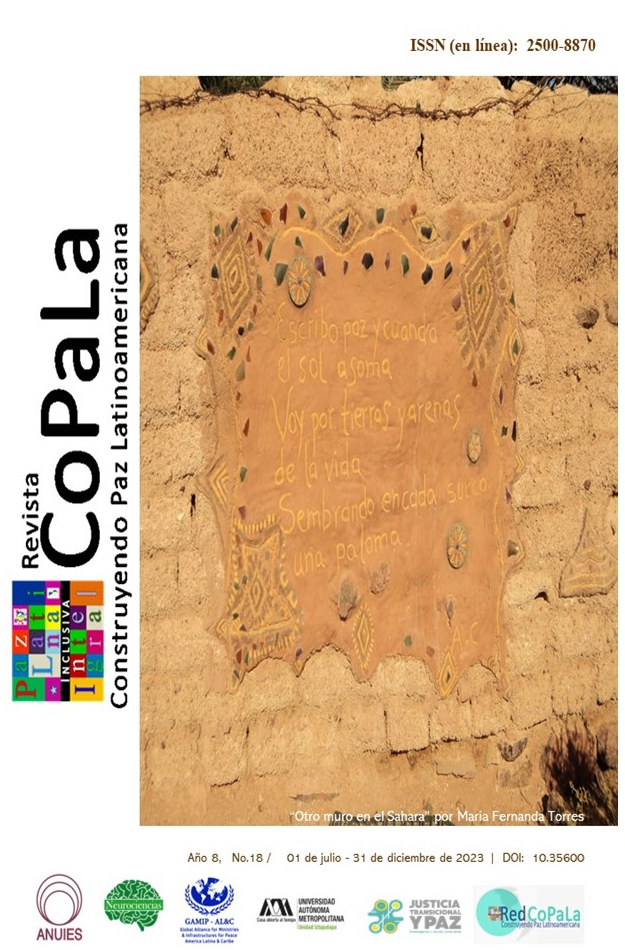The (re) construction of peace through communication
Main Article Content
Abstract
When living in a violent environment, the construction of peace implies communication processes that help to discern what is observed. Mexico is going through difficult times where entire regions survive in high-risk conditions. Some of these regions seem to be overcoming the insecurity caused by the fight of criminal groups that seek control of the territory and the containment actions against them by the security forces. In the state of Tamaulipas, the population became an information manager that kept them safe from criminal actions. The study of this communicative process sheds light on one of the many ways in which people decided not to be intimidated by a violent reality and exercise, to the extent possible, damage control that allowed them to recovered peace and continue their lives. they modified their habits and provided themselves with valuable information that helped them created bonds of peaceful coexistence with their peers, whether they were part of their close circle or did not belong to their family environment.
Downloads
Article Details

This work is licensed under a Creative Commons Attribution-NonCommercial-ShareAlike 4.0 International License.
References
Bibliografía
Aguirre, J. (2016). La tecnología de la información y comunicación en la prevención del delito. https://revistas.flacsoandes.edu.ec/urvio/article/view/1962/1465.
Amaya, H. (2017). The Cultures of Anonymity and Violence in the Mexican Blogosphere. International Journal of Communication. https://static1.squarespace.com/static/62191941f0a1203e25aba925/t/62ba145d1c9cc6764eb8b14b/1656362077872/The+Cultures+of+Anonymity+and+Violence+in+the+Mexican+Blogosphere.pdf.
Benaissa, S. (2021). Prosumidores y redes sociales: manifestaciones del nuevo periodismo ciudadano. https://www.researchgate.net/profile/Samia-Benaissa-Pedriza/publication/355411273_Prosumidores_y_redes_sociales_manifestaciones_del_nuevo_periodismo_ciudadano/links/61ba3361a6251b553abe06fa/Prosumidores-y-redes-sociales-manifestaciones-del-nuevo-periodismo-ciudadano.pdf.
Calderón, L. (2016). Tamaulipas, un estado emblemático en la lucha contra la violencia: prácticas comunicativas en un ambiente de excepción. [Tesis de doctorado, Universidad Nacional Autónoma de México]. https://tesiunam.dgb.unam.mx/F/5AVFF3GNE8E4SCBMHSDBFHN14AA167FBARMU9R1KCQL5REET9Q-21502?func=find-b&local_base=TES01&request=Tamaulipas%2C+un+estado+emblem%C3%A1tico+en+la+lucha+contra+la+violencia&find_code=WRD&adjacent=N&filter_code_2=WYR&filter_request_2=2016&filter_code_3=WYR&filter_request_3=2016.
Castillejos, B. (2018). Gestión de información y creación de contenido digital en el prosumidor millenial. https://www.scielo.org.mx/pdf/apertura/v11n1/2007-1094-apertura-11-01-24.pdf
Chávez, Y. y Pérez H. (2013). Gestión documental, Gestión de Información y Gestión del conocimiento: nociones e interrelaciones. http://revistas.bnjm.cu/index.php/BAI/article/view/287/297.
Fajardo, C. (2020). El impacto del periodismo ciudadano en el periodismo digital, caso Paro Nacional 2019. [Tesis de licenciatura, Universidad Técnica de Babahoyo, Ecuador] http://dspace.utb.edu.ec/bitstream/handle/49000/8808/E-UTB-FCJSE-CSOCIAL-000307.pdf?sequence=1&isAllowed=y
Franca, M. (2022). “Su abuelo humilló a los muertos y a los vivos”: la memoria del franquismo en el discurso digital. Refracción Revista sobre Lingüística Materialista. Universidad Federal de Paraná. https://digitum.um.es/digitum/bitstream/10201/116524/1/1-n%c2%ba5-matheus.pdf.
Gómez, et al (2020). El papel de los medios de comunicación en la fabricación de recuerdos, emociones y creencias sobre el enemigo que facilitan la polarización política y legitiman la violencia. http://www.scielo.org.co/scielo.php?script=sci_arttext&pid=S1657-80312020000100018
Hernández, G. (2014). Emmequis: Valor por Tamaulipas, la otra autodefensa. 10 febrero 2014. http://www.m-x.com.mx/2014-02-09/valorxtamaulipas-la-otra-autodefensa/comment-page-1/.
López Obrador, A. M. (2018). Plan de Paz y Seguridad. https://lopezobrador.org.mx/wp-content/uploads/2018/11/PLAN-DE-PAZ-Y-SEGURIDAD_ANEXO.pdf
Quintero, P. (2018). Seguridad Ciudadana y participación de las comunidades en América Latina. Revista Científica General José María Córdova, https://revistacientificaesmic.com/index.php/esmic/issue/view/21/18.
Ocaña-Fernández, Y., et al. (2019). Preferencias Gestión del conocimiento y tecnologías de la información y comunicación (TICs) en estudiantes de ingeniería mecánica. https://www.redalyc.org/journal/4676/467663403006/467663403006.pdf.
Ochoa, A. (2017). Los silencios de la Guerra. Editorial Universidad del Rosario.
Mac Donald, R. (2017). Las funciones de Roman Jakobson en la era digital. Editorial Cara Parens. Universidad Rafael Landívar.
Marthoz, J. (2018). Los medios de comunicación y el terrorismo: manual para periodistas. UNEDOSC Biblioteca Digital. https://unesdoc.unesco.org/ark:/48223/pf0000366284.
Rico, D. et al. (2017). El papel de la identidad, la eficacia y las emociones positivas en las acciones colectivas de resistencia pacífica en contextos violentos. Revista Latinoamericana de Psicología. http://www.scielo.org.co/scielo.php?script=sci_arttext&pid=S0120-05342017000100028
Tobón, V. et al. ( 2020). Reconstruir La Paz En La Escuela Mediante La Recuperación De La Memoria Histórica Desde Una Perspectiva Educomunicativa. https://bibliotecadigital.udea.edu.co/bitstream/10495/17289/2/RiveraWilson_2020_MemoriaHist%C3%B3ricaEducomunicaci%C3%B3n.pdf.
Trifu, A. (2018). Reflexiones sobre la paz positiva. Un diálogo con la paz imperfecta. https://revistaseug.ugr.es/index.php/revpaz/article/view/5602/7027.
Waisbord, S. (2020). ¿Es válido atribuir la polarización política a la comunicación digital? Sobre burbujas, plataformas y polarización afectiva. http://www.scielo.org.ar/scielo.php?script=sci_arttext&pid=S1853-19702020000200248.





